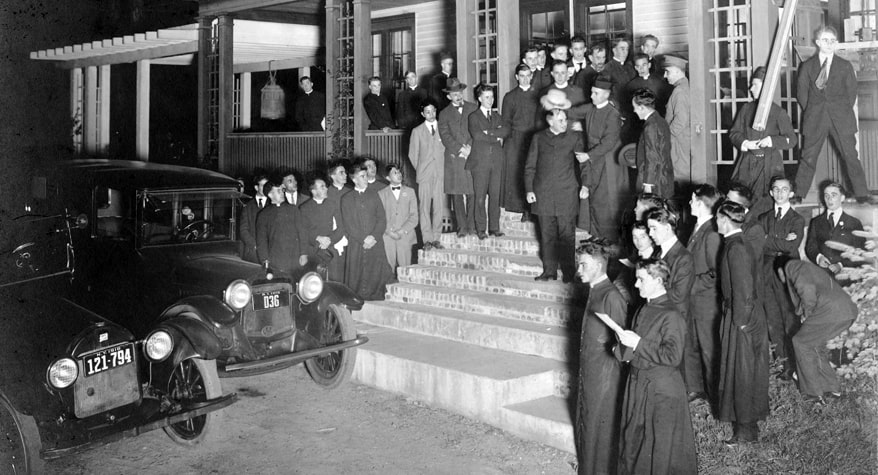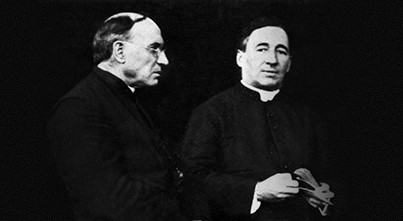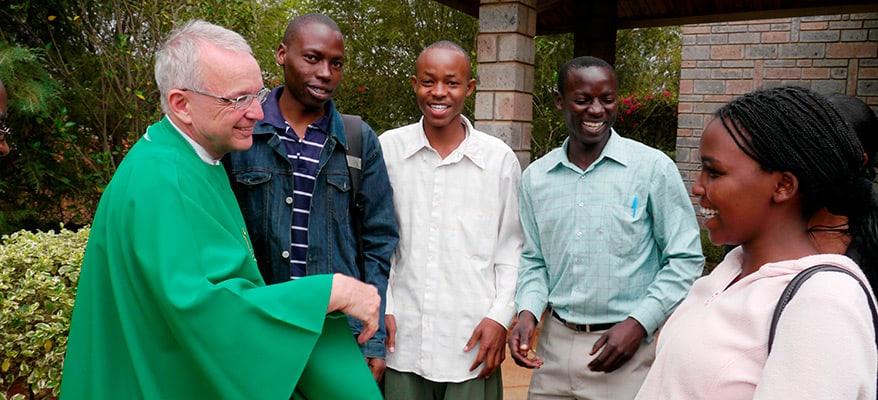A century ago, an attentive subscriber to the Catholic mission magazine The Field Afar might have noticed the following announcement in its pages: “Youths or young men who feel a strong desire to toil for the souls of heathen people and who are willing to go afar with no hope of earthly recompense and with no guarantee of a return to their native land are encouraged to write, making their letter personal, to the Editor of Field Afar.”
That year, 1911, was far from the heyday of American Catholic missionary enterprises; rather, the editor, James A. Walsh, M.M., was addressing readers in the United States, whose church had been removed from the Vatican’s roster of mission territories only three years before and for whom the notion of sending missionaries abroad was a foreign one indeed. In the words of the historian Msgr. John Tracy Ellis, the first decade of the 20th century was a time when the Catholic Church in the United States finally “attained ecclesiastical adulthood.” The great migrations of European Catholics to the United States were ongoing, and Catholics were trying to take root in a culture more or less hostile to “popery.” As a result, the energies of the institutional church were often directed inward. Out of the 17,000 Americans serving as Catholic priests at the time, for example, the number serving in foreign missions was 14.
The story would change dramatically over the next few decades, however, as the psychology of the U.S. Catholic Church reversed from that of mission territory to that of missionary culture. A driving power behind that transformation was the Maryknoll Fathers and Brothers, the Congregation of Maryknoll Sisters and, eventually, the Maryknoll Lay Missioners—collectively known as Maryknoll. The Maryknoll congregations were the first Catholic institutes founded in the United States with a specific focus on overseas mission. Over the next century they would send thousands of men and women religious as well as lay missionaries across the globe in the service of evangelization and work with developing peoples.
As the Maryknoll family celebrated its centennial throughout 2011, a look back at its history makes clear that alongside its evangelical mission, Maryknoll also played an important sociopolitical role in U.S. culture. For many Catholics around the world, the Maryknoll missionary became the public face of the American “brand” of Roman Catholicism for much of the 20th century. At the same time, the inspiring and sometimes tragic stories of Maryknoll missioners overseas had a powerful effect on the American national imagination, a phenomenon that continues today, not only in religious circles but in political and social realms as well.
Founding Fathers and Mothers
The history of Maryknoll begins with three names: James A. Walsh, Thomas F. Price and Mary Josephine Rogers (known as Mollie and later as Mother Mary Joseph). The first, a Boston priest who had been appointed diocesan director of the Society for the Propagation of the Faith in 1903, was also founder of The Field Afar, an English-language magazine designed to support foreign missionaries.
Mollie Rogers was a schoolteacher and a 1905 graduate of Smith College. She traced her own desire for mission work to an experience she had while a junior at Smith when she witnessed some of the school’s brightest students dancing in public in celebration of their pledge to go to China to work in Protestant mission schools or hospitals. “Something—I do not know how to describe it—happened within me,” she wrote. “I passed quickly through the campus to St. Mary’s church, where, before Jesus in the tabernacle, I measured my faith and the expression of it by the sight I had just witnessed. From that moment I had work to do, little or great, God alone knew.”
She met Father Walsh in December of 1906, and the two shared their interests in missionary work in foreign lands, particularly China. With his encouragement, Ms. Rogers organized a Mission Study Club for Catholic students at Smith in 1906. While working as teacher in the following years, she volunteered at The Field Afar as an editor and translator.
Thomas F. Price was a diocesan priest from North Carolina (the first native-born Catholic priest ordained in the state). He founded the Catholic periodical Truth for the people of North Carolina at a time when scholars estimate there may have been as few as 800 Catholics in the entire state. He also founded an orphanage and a regional seminary for “home missionaries” in North Carolina, serving as rector of the latter from 1902 to 1909.
It is worth noting that James Walsh is the only one of the founders whose story of entering religious life can be seen as fairly typical for a Catholic in the United States at the time. Both Father Price and Ms. Rogers were anomalies, the former accustomed to working in non-Catholic contexts in the American South and the latter college-educated in non-Catholic schools. Neither had any experience of convent life or traditional missionary work, and none of the three were members of European-style religious communities.
After years of correspondence, Father Price and Father Walsh met in Montreal in 1910 at the 21st Eucharistic Congress, where they shared their similar vision of an American “foreign mission” enterprise. In April of 1911, with the encouragement of Cardinal James Gibbons of Baltimore, the two priests submitted to the U.S. bishops their proposal for a new institute of foreign missionaries and on June 29, 1911, gained official sanction for the new “Catholic Foreign Mission Society of America,” with Father Walsh as its first superior general.
The first group of six seminarians joined in the fall of 1912, when the order also moved its headquarters to a hilly 93-acre farm in Ossining, N.Y., which they named Mary’s Knoll. They were joined in 1912 by four women, including Mollie Rogers, who became the superior of the Teresians. While Father Walsh seems to have envisioned them as a kind of ladies’ auxiliary assisting in the quotidian operations of the seminary, Mollie Rogers retained her vision of direct overseas service.
In September 1918 the first group of Maryknoll men left for China. Father Price was appointed the group’s superior but died in Hong Kong almost exactly a year later of appendicitis. The first group of Maryknoll women religious was missioned to China in 1921.
Over There
In China and Korea, the adaptability of the mostly young, mostly American members of the first mission groups proved valuable. China’s interior was not only isolated but underdeveloped by Western standards. Everything from travel to catechetical methods to cloistered living needed adaptation from the Euro-American norm. The American background of the early Maryknollers made them uniquely suited for foreign mission work. Untethered to geographic locations or class distinctions, their attitudes and lifestyles differed markedly from more traditional expressions of Catholic religious life. A more freewheeling approach was also encouraged in their training as missionaries, where both Father Walsh and Sister Rogers stressed that adaptability and individuality could be positive virtues in the missions, rather than simply temptations toward disobedience or pride.
The importance of the “American style” became apparent soon after in Kaying, one of the Maryknoll mission territories of China. After a visit from Sister Rogers in 1923 produced much excitement among the local population (who had never seen a Western woman in direct evangelical work), the local superior, Father Francis Ford, created the Kaying Method, in which religious women were sent out in pairs, living among the local populations for a month at a time or traveling from remote village to village, training lay catechists and establishing contacts with unevangelized areas. They were cut off from the sacramental life of their communities for long periods and also lived with far less privacy than was customary for religious women, making the method controversial. By 1939, however, because of the success of the model (and the large numbers of Maryknollers volunteering for such work), the Kaying Method received a commendation from the Vatican, and its use became widespread throughout mission territories in China.
When the all-encompassing violence of World War II (and the U.S. entry into the war in 1941) drastically curtailed Maryknoll’s ability to send new missionaries to Asia, its superiors were quick to adapt. Although many missionaries chose to remain in their assignments (some suffering persecution at the hands of Japanese occupiers as supposed American spies), most of the established missions were cut off. Within a year, Maryknoll superiors had established a number of new missions in South America and Central America. Within two decades, more than 25 percent of Maryknoll’s members were working there; by 1948, the Maryknoll Sisters had expanded to Africa.
These efforts were supported financially by donations from the United States, many of them inspired by the stories of missionary efforts told in The Field Afar (later Maryknoll magazine). The magazine’s circulation had soared past 90,000 within a few years of Maryknoll’s founding and enjoyed strong popularity for its stories of typically American young men and women toiling humbly but heroically in exotic foreign places. Maryknoll also benefited from publicity in secular newspapers and magazines enamored of the all-American stories and images of Maryknollers overseas. As a result, for several generations of Americans the image of the Maryknoll missionary became a powerful symbol of the American church’s evangelical zeal and reach.
The association of Maryknoll with the international fight against Communism became more pronounced after the Communist rise to power in China in 1949 brought Maryknoll some of its first martyrs. Many suffered in virtual anonymity, though the stories of two Maryknoll bishops became famous in the United States: Francis X. Ford, who created the Kaying Method; and James E. Walsh. Both had been among the first group to arrive in China in 1918.
Ford had been ordained a bishop in China in 1935. He and his secretary, Sister Joan Marie Ryan, were arrested by Chinese Communist authorities on charges of espionage in 1950 and publicly beaten by mobs as they were taken from town to town in the region. The last American to see Bishop Ford before his death in prison in 1952 described him as so emaciated that another prisoner carried him “like a sack of potatoes.”
Father James E. Walsh served for 18 years as superior of the Maryknoll missions in China and was ordained a bishop in 1927. He was arrested in 1959 on charges of espionage and given a 20-year prison sentence. He served almost 12 years in nearly complete isolation before his sudden release in 1970 at the age of 79, presumably as sop to U.S. President Richard Nixon before his visit to China. The high public profile and obvious suffering of the two Maryknoll bishops made headlines in the United States, where they were lionized in the popular press for their anti-Communism as much as for their religious commitment.
A New Direction
Following the Second Vatican Council, the mandate for reform of religious orders brought new challenges and opportunities to the Maryknoll congregations, particularly from that council’s explicit calls for greater solidarity with the poor, new approaches to evangelization and a greater role for the laity in the mission of the church. The presence of Maryknoll missionaries on the front line of evangelization efforts in the developing world gave particular urgency among Maryknoll’s members to the implementation of all three aspects of this vision in the decades that followed. The political and ecclesial implications were to bring Maryknoll’s missionaries into the forefront of the American imagination once again, with new champions and new detractors.
Instead of China, the new flashpoint was Central America, where the work of Maryknoll missionaries on behalf of the poor and marginalized aroused the ire of repressive governments and raised again the specter of martyrdom. The most famous of these martyrs are “the churchwomen of El Salvador,” Sister Ita Ford (a Maryknoll missionary and cousin of Bishop Francis X. Ford), Maura Clarke (a Maryknoll missionary), Dorothy Kazel (an Ursuline missionary) and Jean Donovan (a Maryknoll lay missionary). All four women were working in El Salvador in the late 1970s in various church ministries aiding the poor and refugees from that nation’s bloody civil war.
At a Maryknoll conference in Managua in December of 1980, Sister Ford read from a homily of Archbishop Oscar Romero of El Salvador, who had been assassinated earlier that year: “Christ invites us not to fear persecution because, believe me, brothers and sisters, the one who is committed to the poor must run the same fate as the poor, and in El Salvador we know what the fate of the poor signifies: to disappear, be tortured, to be held captive—and to be found dead.”
Upon returning to El Salvador, Sister Ford disappeared along with Sister Clarke, Sister Kazel and Ms. Donovan. Their bodies were discovered days later; all four had been tortured, raped and murdered by members of the Salvadoran National Guard. The news reached the United States almost immediately, and the public outcry grew after the publication of clumsy and conflicting statements by Salvadoran government and military officials attempting to deny or distance themselves from the crimes. For many Americans, the martyrdom of the four missionaries was their first public exposure to a new face of American missionary efforts against structural injustice and political repression—the latter often perpetrated not by a demonized “red menace” but by foreign governments propped up by American financial and military support as a supposed bulwark against Communism.
A U.N. commission later established that the murder of the four women was not only premeditated; it had been ordered by officials in the highest ranks of the Salvadoran military. Press coverage in the United States of the murders and ensuing political machinations played a significant role in bringing some of these officials to justice, as well as the eventual suspension of military and economic aid to the Salvadoran regime. In the decades since, the churchwomen have become symbols of the church’s evangelical efforts against structural economic injustice and political repression, just as in earlier generations Bishops Ford and Walsh had inspired Catholics attuned to the dangers of the oppressive and atheistic Communist regimes.
Quo Vadis?
The mid-1990s brought efforts at re-evaluation and reorganization to all branches of the Maryknoll family. As vocations to religious life have remained at historic lows in recent decades in the United States, the Maryknoll congregations have an increasingly international face; new members are as likely to come from one of the 37 countries in which Maryknoll missionaries work as from the United States.
This global membership parallels a greater emphasis on the dangers and opportunities of globalization in Maryknoll’s evangelical work. A vision statement released by the Maryknoll Fathers and Brothers in 1996 called on its members to “join the struggles for justice of the poor, indigenous peoples and women against economic, social and cultural oppression” and “in announcing the healing, reconciling and liberating Jesus.”
It is not the language of a century ago, when Father James A. Walsh called for American missionaries to serve in foreign lands “to toil for the souls of heathen people.” That message found a favorable welcome among a generation of American Catholics seeking to serve a newly confident church’s efforts in a particularly American enterprise. So too did later generations find inspiration in the efforts of Maryknollers in China, in Central America and in countless other locales. As Maryknoll begins its second century in a church that sometimes seems to be turning inward again to deal with its own concerns, can the outward thrust and global mission of its congregations offer a similar challenge to a new generation of American Catholics?
James T. Keane, S.J., a former associate editor of America, is a student at the Jesuit School of Theology in Berkeley, Calif.
This article appeared at http://www.americamagazine.org/content/article.cfm?article_id=12918




